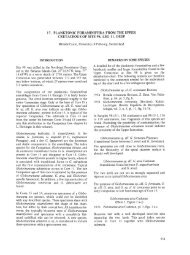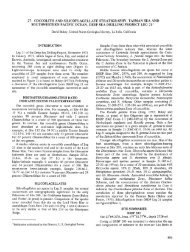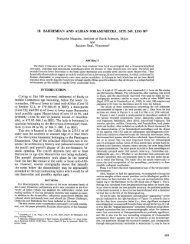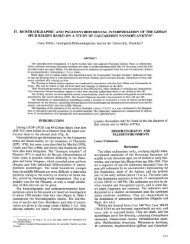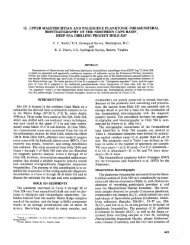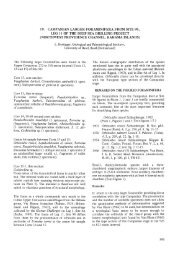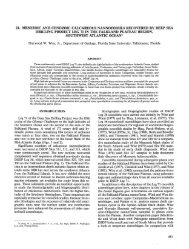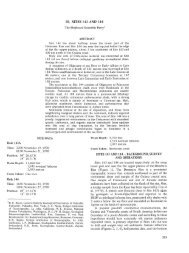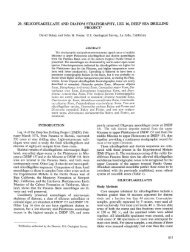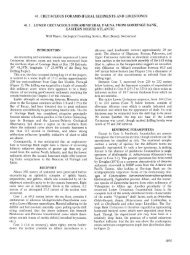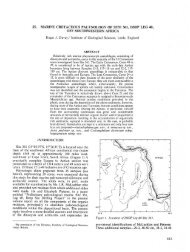16. Radiolaria - Deep Sea Drilling Project
16. Radiolaria - Deep Sea Drilling Project
16. Radiolaria - Deep Sea Drilling Project
You also want an ePaper? Increase the reach of your titles
YUMPU automatically turns print PDFs into web optimized ePapers that Google loves.
M. G. PETRUSHEVSKAYA, G. E. KOZLOVA<br />
Sample<br />
1-1, 80-82 cm<br />
1-2, 80-82 cm<br />
1-3, 80-82 cm<br />
2-2, 88-90 cm<br />
4-2, 88-90 cm<br />
5-1, 80-82 cm<br />
5-1, 138-140 cm<br />
8-2, 106-108 cm<br />
9-1, 98-100 cm<br />
9-2, 58-60 cm<br />
9-3, 90-92 cm<br />
9-CC<br />
CB<br />
TABLE 11<br />
<strong>Radiolaria</strong>ns in Site 142<br />
Abundance<br />
Preservation<br />
Cannartus tubarius<br />
Stichocorys delmontensis<br />
Lithocampe (Cyrtocapsella) tetrapera<br />
Calocycletta veneris<br />
Stylatractus santaennae<br />
Cyrtophormis armata<br />
Stichocorys wolfii<br />
Cannartus violina<br />
Theocamptra corona<br />
Calocycletta costata<br />
Lithocampe cornuta<br />
Cannartus mammiferus<br />
Dendrospyris pododendros group<br />
Rhodospyris sp. aff. tricornis<br />
Lithotympanium tuberosum<br />
Otosphaera annikae<br />
Tympanomma binoctonum<br />
Trissocyclus stauropora<br />
Theocamptra sp. aff. T. marylandica<br />
Dorcadospyris dentata<br />
Eucornis sp. A<br />
Carpocanistrum cristatum<br />
Cromyechinus tetrapyla<br />
f<br />
a<br />
c<br />
c<br />
r<br />
From 641 to 645 meters below the sea floor (Core 8),<br />
poorly preserved (dissolved, pyritized and so on) skeletons<br />
of Cretaceous radiolarians occur.<br />
m<br />
m<br />
m<br />
m<br />
m<br />
JO 1 1 1 I I<br />
Hole 140A<br />
From 235 to 244 meters below the sea floor (Core 2,<br />
Sections 3, 4, 5 and 6, 8-10 cm) rare fragments of<br />
radiolarians which seem to belong in the Calocycletta<br />
tuberosa Zone, occur. The lower part of Core 2 (samples 6,<br />
80-82 cm and 140A12-CC) contains nearly the same<br />
assemblage as on the slide marked as 140-2-CC; it seems to<br />
belong in the upper part of the Thyrsocyrtis bromia Zone.<br />
This part of that zone was observed by T. Moore (1970, see<br />
Leg 8, Site 69, Sections 9-1, 9-3).<br />
Site 141 (19° 25.16'N, 23° 59.91'W; water depth 4148<br />
meters)<br />
Only in Sample 2-CC occur well preserved, rare Miocene<br />
radiolarians.<br />
514<br />
b i l l<br />
TI 1 I TI<br />
C<br />
C<br />
F<br />
R<br />
F<br />
R<br />
F<br />
F<br />
R<br />
A<br />
F<br />
F<br />
JO 1 TI TI<br />
1 b 1 1<br />
F<br />
F<br />
R<br />
R<br />
JO 1 JO 1<br />
1 I 1 jo<br />
b i l l<br />
C<br />
F<br />
R<br />
R<br />
C<br />
F<br />
R<br />
R R R R<br />
R<br />
R<br />
C<br />
R<br />
R<br />
b i l l<br />
1 1 1 TI<br />
-<br />
1 1 1 ?° 1 1 1 1 | | 1<br />
Zone<br />
Calocycletta costata Zone<br />
Calocycletta<br />
veneris<br />
Zone<br />
Site 142 (03° 22.1 l'N, 42° 23.5l'W; water depth 4350<br />
meters<br />
<strong>Radiolaria</strong>ns are common only from 575 to 581 meters<br />
below the sea floor (Core 9).The skeletons are moderately<br />
preserved: many specimens are destroyed; nasellarians<br />
without heads were found. The assemblage is poor in<br />
species. The lower part of Core 9 appears to belong in the<br />
Calocycletta veneris Zone, and the upper part in the<br />
Calocycletta costata Zone.<br />
Site 144 (09° 27.23'N, 54° 20.52'W; water depth 2939<br />
meters<br />
Hole 144<br />
<strong>Radiolaria</strong>ns of good preservation are very abundant<br />
from 57 to 61 meters (Core 1). They seem to belong in the<br />
Lampterium goetheana Zone. The samples from 61 to 63<br />
meters below the sea floor (samples from 1-6, 1-CC) are<br />
also abundant in radiolarians. The skeletons are of good



